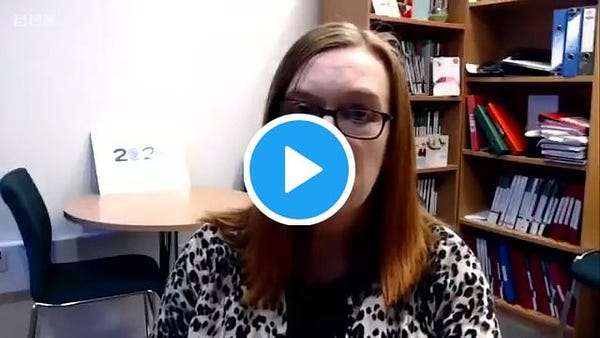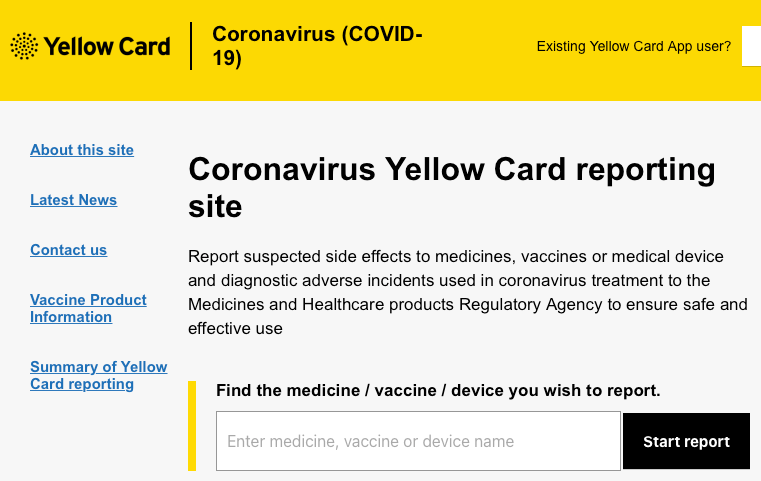Is it safe? New data on COVID-19 vaccine safety
Delayed doses, variants, and why punching people in the face does not work.
If you find this post interesting and think others might do so, spread the word.
Reassuring data on COVID-19 vaccines
Vaccines are still given to healthy people and by June 2021 the expectation is that all adults will have been vaccinated. Ensuring we can rapidly find any unknown adverse effects is essential. That is where the Yellow Card Scheme comes in. It is a spontaneous reporting scheme for adverse effects. Spontaneous because it depends on the ‘spontaneous’ decisions of healthcare professionals, patients, and carers making a link between some adverse event someone taking a drug or vaccine experiences and having a suspicion that it might be linked to the use of the drug or vaccine they have taken.
You might think that collecting what are essentially case reports is a fairly useless way of finding adverse events compared to clinical trials or data-mining routine healthcare data. It isn’t. One analysis found such reports contributed to 95% of drug withdrawals. That vigilance and suspicion from reporters is valuable. You need a haystack and a needle to find a needle in a haystack, and spontaneous reporting systems provides both (assuming there is a needle to find, which there might not be).
Clinical trials have deficiencies in finding rare adverse events (greater than 1 in 10,000 people) because of the cohort size, but in the UK now over 12 million people have had a single dose of the AZ vaccine or the Pfizer vaccine. If there are rare but serious adverse effects of the vaccines, this provides a big enough pool of individuals to see potential adverse effects - assuming they are reported. Even with under-reporting rates of 94%, you can still find signals of potential harms. The other benefit is speed. This is real-time data that can be collected quickly as the vaccine programme rolls out.
So far, the MHRA are reporting ‘that the safety of these vaccines remains as high as expected from the clinical trial data that supported the approvals. The safety profile of the vaccines remains positive and the benefits continue to far outweigh any known side-effects.’ Between the 9 of December 2020 and 24 of January 2021, this equates to 3 reports per 1000 vaccinations. Most of this is mild, like sores arms and flu-like symptoms. Of course, as already mentioned there will be quite a high level of under-reporting so sore-arms and flu-like symptoms will probably be far more common. That said, what the MHRA will be concerned about is more serious rare events.
The MHRA don’t just depend on clinical trials and the Yellow Card Scheme, and have a well thought out pharmacovigilance plan you can read here. There will be targeted studies and pharmacoepidemiological studies. I’ve been working in a vaccine hub, and have been impressed by the record keeping, which is going to pay off in the future when these safety studies are conducted.
The MHRA have published a summary of the safety data, as well as individual reports on each vaccine (list here). Up to the 24th of January 2021 the MHRA had received 6,014 reports of suspected adverse effects to the AZ vaccine, and 16,756 reports to the Pfizer vaccine (remember that vaccine had a month’s head-start, so you can’t compare using reports). Amazing only 50 reports were to an unspecified COVID-19 vaccine. In total 101 reports of anaphylaxis were received to the Pfizer vaccine (all recovered), and 13 to the AZ vaccine. Initial advice for people with a history of anaphylaxis to any medicine, vaccines and food to avoid the Pfizer vaccine after some earlier reports was dropped, and now only ‘a previous history of allergic reactions to the ingredients of the vaccine’ are the reason to avoid the Pfizer vaccine.
There have also been some reports of Bell’s Palsy, a form of facial paralysis (which eases with time), but this appears to be not linked to the vaccines. Bell’s Palsy occurs at a natural rate in the population in the absence of the vaccine, so if you vaccinate millions of people, some will coincidently develop Bell’s Palsy after the vaccine is administered without any causative mechanism. The same goes for deaths following the vaccine, particularly when given to frail older patients who were in the initial wave of vaccinations. The trick is to monitor the rates to ensure that they are not higher than one would normally expect in the population.
Overall, this is great news, and the MHRA’s plans for safety monitoring and transparency should give the public trust in the processes in place to ensure safety. As a last point, it has to be re-iterated that this is nothing different than the roll out of any other vaccine or drug. All drugs and vaccines have provisional safety details until used in the wider population, so the COVID-19 vaccines are no more theoretically dangerous in that respect than anything else. However, given the importance of ensuring public trust and ensuring that vaccine hesitancy is minimised, everything the MHRA are doing is important.
If you have been vaccinated, you can report any side effects at this special site: Yellow Card Scheme
Covid Symptom Study
The COVID symptom study are also collecting adverse effect data on the vaccines via their app. Their data appears to have a higher rate of reporting, allowing them to make these statements about the minor groggy symptoms and sore arms:
We found that around one in seven people who received one dose of the vaccine experienced at least one systemic effect within seven days of their jab.
We also found that around four in ten people who received their first dose had at least one after effect in their arm, most commonly pain and swelling in the day or two after the jab.
Most symptoms happen in the first two days after vaccination, with headache, fatigue and chills or shivers being the most common
They also find the second dose seems to have more of these minor side effects. These sorts of frequencies certainly tally with the admittedly totally anecdotal data I’ve been receiving from friends and family.
Mixing vaccines
At the start of January there was talk about the UK having a mixed-vaccine dosing strategy, but this was false. However, there were plans for studies to examine if this was a way forward, since there are obvious benefits if this could be done in case of vaccine shortages. The COVID-19 Heterologous Prime Boost study, or ‘Com-Cov’, is now recruiting across eight sites in the UK.
Delayed Doses
The decision by the JCVI to delay UK second doses of COVID-19 vaccines appears to have paid off. Anthony Harnden, deputy chairman of the JCVI, is reported in the Sunday Times as suggesting that the PHE has data, soon to be published, that show that high levels of protection are coming from the first dose of vaccine, reducing infections and mortality. Who knew that the JCVI carefully applying domain expertise to limited clinical trial data to make a decision in a time sensitive context would be a good idea? Delaying that decision until a trial had been done would have meant more deaths. It seems a good call now, especially when data is starting to emerge of a stronger immune response with a longer interval between dosing for the AZ vaccine. In Israel, where 90% of people aged over 60 have had a single dose of the Pfizer vaccine, there seems to be an age specific drop off in COVID-19 cases as well.
Variants
I’ve stopped doom-scrolling about variants. You could spend all day everyday worrying about nightmare scenarios, but until there is really bad news I don’t see the point worrying too much. Slow news is better for you. Tom Chivers has a good piece about variants and what they mean in UnHerd. There is concern about the South African variant, with Oxford University saying their their vaccine offers minimal protection against mild-moderate COVID-19 infection. However work is already being done on the 2nd generation of the AZ vaccine, and Prof Sarah Gilbert is pretty confident that the vaccine still provides some protection against deaths and hospitalisations.


Given we are going to be dealing with COVID-19 for years, getting into a cycle of despair about this on an hour by hour basis seems pointless. We might be in a game of cat and mouse with it for years, but the next 12 months should still be better than the last 12 months. Other companies are developing mRNA vaccines to deal with multiple variants, and there is a rising global capacity in vaccine production. While the variants are a concern that experts need to be on top of, I’m not losing any sleep over them.
COVID conspiracies and information
Researchers at KCL have been looking at social media use and COVID-19. They found social media users were more likely to believe in conspiracy stories. For example:
‘56% of people who believe there’s no hard evidence Covid-19 exists use Facebook as a key information source, almost three times higher than the proportion of non-believers who do (20%).’
Quelle surprise!
Aside from carrying out Buzz Aldrin’s method of persuasion, he punched someone who said he never went to the moon, how do we reach these people? Adam Grant, who has an excellent new book out, has an article out in the New York Times: The Science of Reasoning With Unreasonable People with a suitably immunological metaphor for changing people’s minds:
When we try to change a person’s mind, our first impulse is to preach about why we’re right and prosecute them for being wrong. Yet experiments show that preaching and prosecuting typicallybackfire — and what doesn’t sway people may strengthen their beliefs. Much as a vaccine inoculates the physical immune system against a virus, the act of resistance fortifies the psychological immune system. Refuting a point of view produces antibodies against future attempts at influence, making people more certain of their own opinions and more ready to rebut alternatives.
It’s worth remembering that even the guy Aldrin punched in the face didn’t change his mind….
I already noted earlier how the MHRA was being transparent, and the Full Fact have an interesting report [PDF] called ‘Fighting a pandemic needs good information’, which supports this approach.
It’s better to get on someone’s emotional level and be honest and transparent, rather than beating them over the head with facts.
Other things I came across this week I think are worth reading:
Dhruv Kullar in The New Yorker on how vaccination will change his behaviour. ‘While waiting for new data to come in, or for those around me to get vaccinated, I’ll continue wearing full protective gear when caring for patients. And I’ll keep avoiding close contact with friends and loved ones who aren’t vaccinated.’
Rowland Manthrope at Sky on how the UK Vaccine Deal came about, Bruno Macaes in UnHerd on Why the EU lost the vaccine war, and an interesting interview in La Republica with Kate Bingham who was behind the UK’s vaccine procurement plan (You can see her slide set and an end of year report on the plan online).
The UK had a very strategic approach, which was to secure vaccines quickly. And the European approach seems to be more sort of a more typical procurement approach, which was more about making sure you got the best value for money for your vaccines.
Stay safe.
Anthony
Don’t forget to report your suspected adverse effects from medicines and vaccines. In the UK, this means using the Yellow Card Scheme.




Stop worrying overmuch about variants and follow a slow news cycle seems excellent advice. Thanks for the updates.